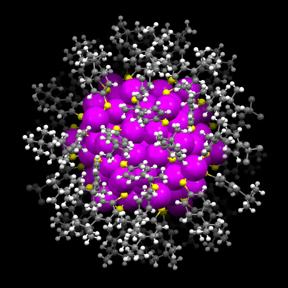A 133 atom gold nanoparticle bears a resemblance to the Milky Way and to DNA’s (deoxyribonucleic acid) double helix according to an April 9, 2015 news item on ScienceDaily,
Our world is full of patterns, from the twist of a DNA molecule to the spiral of the Milky Way. New research from Carnegie Mellon chemists has revealed that tiny, synthetic gold nanoparticles exhibit some of nature’s most intricate patterns.
Unveiling the kaleidoscope of these patterns was a Herculean task, and it marks the first time that a nanoparticle of this size has been crystallized and its structure mapped out atom by atom. The researchers report their work in the March 20 [2015] issue of Science Advances.
“As you broadly think about different research areas or even our everyday lives, these kinds of patterns, these hierarchical patterns, are universal,” said Rongchao Jin, associate professor of chemistry. “Our universe is really beautiful and when you see this kind of information in something as small as a 133-atom nanoparticle and as big as the Milky Way, it’s really amazing.”
An April 8, 2015 Carnegie Mellon University news release (also on EurekAlert but dated April 9) by Jocelyn Duffy, which originated the news release, offers a description of gold nanoparticles along with details about the research,
Gold nanoparticles, which can vary in size from 1 to 100 nanometers, are a promising technology that has applications in a wide range of fields including catalysis, electronics, materials science and health care. But, in order to use gold nanoparticles in practical applications, scientists must first understand the tiny particles’ structure.
“Structure essentially determines the particle’s properties, so without knowing the structure, you wouldn’t be able to understand the properties and you wouldn’t be able to functionalize them for specific applications,” said Jin, an expert in creating atomically precise gold nanoparticles.
With this latest research, Jin and his colleagues, including graduate student Chenjie Zeng, have solved the structure of a nanoparticle, Au133, made up of 133 gold atoms and 52 surface-protecting molecules—the biggest nanoparticle structure ever resolved with X-ray crystallography. While microscopy can reveal the size, shape and the atomic lattice of nanoparticles, it can’t discern the surface structure. X-ray crystallography can, by mapping out the position of every atom on the nanoparticles’ surface and showing how they bond with the gold core. Knowing the surface structure is key to using the nanoparticles for practical applications, such as catalysis, and for uncovering fundamental science, such as the basis of the particle’s stability.
The crystal structure of the Au133 nanoparticle divulged many secrets.
“With X-ray crystallography, we were able to see very beautiful patterns, which was a very exciting discovery. These patterns only show up when the nanoparticle size becomes big enough,” Jin said.
During production, the Au133 particles self-assemble into three layers within each particle: the gold core, the surface molecules that protect it and the interface between the two. In the crystal structure, Zeng discovered that the gold core is in the shape of an icosahedron. At the interface between the core and the surface-protecting molecules is a layer of sulfur atoms that bind with the gold atoms. The sulfur-gold-sulfur combinations stack into ladder-like helical structures. Finally, attached to the sulfur molecules is an outer layer of surface-protecting molecules whose carbon tails self-assemble into fourfold swirls.
“The helical features remind us of a DNA double helix and the rotating arrangement of the carbon tails is reminiscent of the way our galaxy is arranged. It’s really amazing,” Jin said.
These particular patterns are responsible for the high stability of Au133 compared to other sizes of gold nanoparticles. The researchers also tested the optical and electronic properties of Au133 and found that these gold nanoparticles are not metallic. [emphasis mine] Normally, gold is one of the best conductors of electrical current, but the size of Au133 is so small that the particle hasn’t yet become metallic. Jin’s group is currently testing the nanoparticles for use as catalysts, substances that can increase the rate of a chemical reaction.
*ETA April 14, 2015 at 9015 PDT: Coincidentally, researchers in Finland have been examining gold nanoparticles and the size at which they are considered metals and at which they are considered molecules (mentioned in my April 14, 2015 posting [Gold atoms: sometimes they’re a metal and sometimes they’re a molecule]).*
Getting back to patterns, the researchers have provided an A-ray image of Au133,

Caption: The X-ray crystallographic structure of the gold nanoparticle is shown. Gold atoms = magenta; sulfur atoms = yellow; carbon atoms = gray; hydrogen atoms = white.
Credit: Carnegie Mellon
Here’s a link to and citation for the paper,
Structural patterns at all scales in a nonmetallic chiral Au133(SR)52 nanoparticle* by Chenjie Zeng, Yuxiang Chen, Kristin Kirschbaum, Kannatassen Appavoo, Matthew Y. Sfeir, Rongchao Jin. Science Advances 20 Mar 2015: Vol. 1 no. 2 e1500045 DOI: 10.1126/sciadv.1500045
This paper appears to be open access.
* Link updated June 26, 2015.